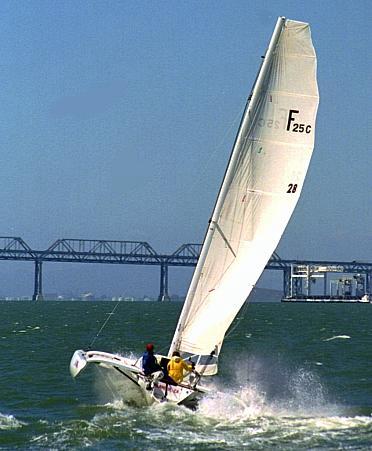Subject: RE: BAMA: DHF-My final comment
Date: Mon, 3 May 1999
21:00:11 -0400
From: John
Kocol <jkocol@tsisoft.com>
To: bama@tango.rahul.net
 What follows is my take on the race and
safety lessons that I personally learned from sailing an F25C (1700 lb.
boat with a 25 foot waterline) in those conditions.
What follows is my take on the race and
safety lessons that I personally learned from sailing an F25C (1700 lb.
boat with a 25 foot waterline) in those conditions.
We did all our homework. We had checked the weather that morning and knew it was really honkin out on the ocean. The previous evening's forecast called for 20-35 mph winds with stronger gusts near the coastline. That morning, we were hearing real-time weather reports from offshore buoys reporting winds from 22 knots to 38 knots with gusts in the forties. All you had to do was turn on your weather radio to know what the conditions were. Although we were prepared and the boat was ready, based on the weather reports we had already concluded that we were probably not going to race. I have a standing policy that I will not take the 25C outside the gate if the wind is blowing steadily more than 25 knots and the waves 10-15 feet or bigger.
In the bay it was a different story. The morning was clear and there was a gentle westerly trickling in the through gate at about 3-5 knots. Since it looked so reasonable inside, we thought we would start the race and then bail out as the conditions roughened (mistake #1, stay with the game plan). We got caught in a real light spot at the start and Erin and F31R's got a pretty good jump on us. When the breeze filled on the north side of the channel, these guys were already one half mile ahead of us and we had to at least catch them (mistake #2, don't let competitive spirit cloud your judgement). We finally got into a strong breeze and we were overtaking the 31's quite rapidly. We caught the first boat around six miles out. We caught Gary about 8 miles out. After we passed him, we noticed that he had started to reef his main. At that point, our downhaul was maxed, but still had another 12" of main traveler left so we kept going. The boat felt great and we were comfortably in control. When the wind reached 25 knots, we reefed the main and the boat felt fine. The wind direction was such that it was a straight shot on starboard tack. We were going so fast with optimal VMG, that South East Farralone was growing rapidly on the horizon. Everytime we looked up at it, it was so much bigger on the horizon that we felt like we could comfortably make it. We were sailing upwind in a real light boat and not thinking about what the ride home would be like (mistake #3, not thinking ahead).
As we approached the island, I estimate that the wind was blowing in the low to mid thirties. The big waves were getting a lot bigger real fast. Many were breaking well offshore of the islands. In this wind and wave condition, I did not want to beam reach across the face of this island to round it. We sailed well high of the island upwind, then bore off from a beat to a run to make sure we maintained control of the boat. The trip back started out rather fun. We were averaging 23 knots flying off the tops of some waves, through others, but in control. We sailed the next 10 miles footing the puffs and heading up in the lulls to maintain our straight shot back to the Golden Gate (broad reach with the true wind at 130 degrees from our course). We were fine until the wind got stronger. Approximately 10 miles offshore, the wind filled to somewhere around forty knots and we soon realized that we did not want to leave the back of the boat. For the next ten miles, we sailed with the jib luffing gently and the main pinned against the shrouds, where the battens took on the shape of an "S" and the trailing edge was starting to curl around the leeward shroud. Letting out sheet made no difference, because the battens were pinned to the shroud. I chose not to intentionally choke the slot (as a depowering mechanism) in order to keep the helm balanced and responsive. If things got worse, we were going to try to foot down to a dead run and try to put in a second reef. Additionally, the waves were huge and confused coming off the Potato Patch shoal, making visibility difficult. We had overtaken the lead monohull (J125 with a 50 foot mast?), which as we approached from astern a few miles back, the whole rig would almost completely disappear in the waves. I was constantly concerned that a shipping channel marker would suddenly appear out of nowhere.
We made it back with no real boat damage. The 25C really took a tremendous pounding. Everything that was supposed to stay dry did. Probably the best lesson that should be learned from our experience is that although we made it around the course, if we would have broke something, we would not have been able to help ourselves. Simply put, that boat is too light and does not have enough water line to negotiate those conditions. Had I been on a larger boat, I would not have considered the endeavor quite so extreme.
Hope that helps-
John Kocol
Director of Sales - Western Region / TSI
Software
510-521-7857
jkocol@tsisoft.com
www.tsisoft.com